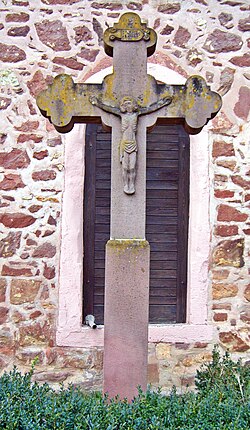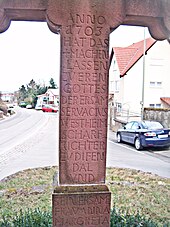Executioner's Cross (Neuleiningen)
| Executioner's Cross | |
|---|---|
 Executioner's Cross Neuleiningen |
|
| Data | |
| place | Newcomers |
| architect | Richard Menges (replica) |
| Client | Servacius Westheim, Anna Margareta Westheim |
| Architectural style | Baroque |
| Construction year | 1703 and 1969 |
| height | 2.30 m |
The executioner's cross is a baroque cross in Neuleiningen , in the Bad Dürkheim district ( Rhineland-Palatinate ).
The cross
It is a baroque sandstone crucifix with ends in the shape of a clover and a stepped shaft; there is no base. The height protruding from the ground is 230 cm, the width 105 cm and the thickness 17 cm.
The property is in an exposed position, shortly after entering the town from the direction of Sausenheim , south of Sausenheimer Straße (L 453), directly in front of the so-called “Heiligenhäuschen” (today's cemetery chapel). The front with the body faces east. On the back, under the IHS monogram and a heart, the following inscription is attached:
" ANNO 1703 HAS MADE THE CROSS TO EREN GOD'S ERSAM SERVACIUS WESTHEIM SCHARFRICHTER TO DIFENDAL AND HIS ERSOMEN WIFE ANNA MARGARETA WESTHEIMEN "
The original cross was badly weathered and was taken to the Historical Museum of the Palatinate in Speyer after the sculptor Richard Menges (1910–1998) from Kaiserslautern had created the now existing, true-to-original copy in 1969. It was set up in 1972.
In the monument topography of the Federal Republic of Germany (Volume 13) it says about it: "The chapel and cross make ... an essential contribution to the picturesque character of the townscape."
When the green space surrounding the cross was repaired in 1996, the bones of an unknown woman were found here and they were buried in the nearby cemetery, where a plaque was dedicated to her.
history
As can be seen from the inscription on the reverse, the cross is a donation made in 1703 by Servacius Westheim and his wife Anna Margareta from Tiefenthal . Westheim was an executioner for the County of Leiningen in his day and only carried out executions with the sword. His assistant, the executioner, carried out the dishonorable punishments of hanging , wheeling, and burning . In contrast to the latter, the executioner had a relatively high social status. Out of the superstition that someone who has an executioner or his wife as a godfather will never die from an execution if they are gladly chosen as “fathers” . Anna Margareta Westheim appears eight times in this capacity in the Catholic Church Register. She died in 1732, her husband in 1711; according to the death entry "pious and after receiving the sacraments " . Both were buried in the old Tiefenthaler Friedhof near today's Protestant church.
In Neuleiningen the legend went that the cross was the burial place of the executioner who was not intended to be buried in consecrated ground. This is refuted by the church book entries. Westheim may have had the monument erected as a kind of atonement cross because of judgments that he had ordered and that put a mental burden on him. It cannot be ruled out that the bones found are those of an executed person who was buried near the cross.
literature
- Cultural monuments in Rhineland-Palatinate, Dürkheim district (Volume 2) , Volume 13 of: Monument topography Federal Republic of Germany , Wernersche Verlagsgesellschaft, 2006, ISBN 3884622153 , p. 430; (Detail scan)
- State Office for the Preservation of Monuments: The Art Monuments of Bavaria , Administrative Region Pfalz, VIII. City and District Frankenthal, Oldenbourg Verlag, Munich 1939, p. 439; (Detail scan)
- Joseph Sprißler: The executioner's cross in Neuleiningen and the executioners in Tiefenthal in the period from 1700 to 1800 , Neue Leininger Geschichtsblätter, Altertumsverein Grünstadt , 1928, p. 83 ff
- Joseph Sprißler: Contributions to the history of Tiefenthal. In: Frankenthaler Geschichtsblätter - monthly publication of the Frankenthaler Altertumsverein. Volume 47, No. 2, February 1939
- Fred Weinmann: cult marks of the Palatinate. Pilger-Verlag, Speyer 1975, pp. 67-69
Web links
- Illustrated website for the Executioner's Cross Neuleiningen (including a black and white photo of the old cross)
- Historical website of the Verbandsgemeinde Hettenleidelheim, with information on the executioner's cross
Coordinates: 49 ° 32 ′ 38.4 " N , 8 ° 8 ′ 34.7" E


